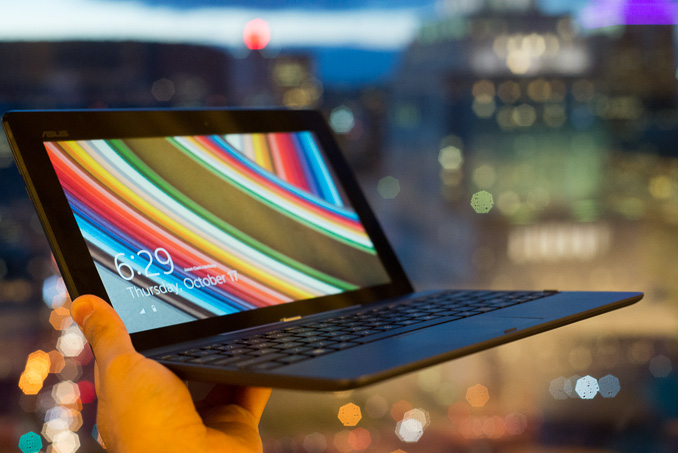ASUS Transformer Book T100 Review: Redefining the Entry-Level Windows Notebook
by Anand Lal Shimpi on October 18, 2013 12:00 AM ESTFinal Words
It’s tough to sell an entry-level Windows PC these days. You’re sandwiched between a couple of aggressive price points: the Nexus 7 at $229 and the iPad at $499. Traditionally, the PC you’d get between those price points would have mechanical storage, the cheapest of cheap TN panels, be bulky as possible, an unimpressive keyboard/trackpad and have 2.4GHz-only WiFi. About the only solace would be that it’d have some insanely quick Core architecture CPU inside, which more or less didn’t matter since the overall experience was hampered so much by the spinning disk inside. Thankfully, times are changing.
Assault first and foremost comes from Google’s latest lineup of Chromebooks. The HP Chromebook 11 addresses many of these concerns but with a fairly limited OS and silicon that’s honestly a bit too slow, even for the target market. But you do get an awesome keyboard, eMMC based storage, and an IPS panel among other things.
The Transformer Book T100 is really the Wintel camp’s answer to the Chromebook onslaught. Compared to the traditional entry-level PCs out there, the T100 really is a breath of fresh air. You get an IPS panel, great battery life and modern WiFi all in a package that can work as both a notebook and a tablet. The system is responsive and predictable in its performance thanks to the use of solid state storage. While there isn’t a full blown SSD inside, the eMMC solution is clearly better for light consumer workloads than a mechanical disk. Solid performance from the rear facing speakers and excellent portability round out the T100’s package. If I had to compare it to what you’d normally expect to get from a $349/$399 Windows PC, I’d say the Transformer Book T100 is a clear winner.
Where things get complicated is if/when you start comparing across platforms. ASUS and Google set the standard for affordable color calibrated displays with the 2013 Nexus 7, and unfortunately the T100 comes no where close to that. Even HP’s Chromebook 11 delivers a more accurate out of box experience than the T100. Again, the T100’s display isn’t bad, it just desperately needs a factory calibration.
It’s important to keep the T100’s performance in perspective. For light multitasking or single app-use workloads, the T100 does very well (much better than the Chromebook 11 we just reviewed). Light browsing and document work are at home on the T100. Don’t expect it to be a Haswell replacement though. I would like to see the gap narrow between Intel’s Atom and Core lines, but I’m afraid it’s going to take real performance pressure from a competitor before we ever see that day.
The dock experience on the T100 is reasonable, but it’s clear to me that the Transformer Book T100 is first and foremost a tablet, and only serves as a clamshell device as a secondary function. That’s not to say it makes for a bad notebook experience, it can just be cramped as a result of the 10.1-inch display footprint. If you’re looking for a device that you’ll use mostly as a tablet but want the flexibility of turning it into a notebook when you need to, the T100 can definitely fit the bill. If your desire is primarily for a touchscreen notebook, then the T100’s tradeoffs may be more frustrating.
At the end of the day the T100 is a good device, but like the Chromebook 11 we recently reviewed it could’ve been amazing with a few tweaks. With a less reflective display, color calibration at the factory and a better feeling keyboard/trackpad I’d be absolutely in love with the T100. I also wonder if 10.1-inches is the right form factor for this sort of a device. I’m not sure that Microsoft’s decision to go with 10.6-inches is the right one either, but the typing experience on a Surface’s type/touch covers does feel remarkably less cramped.
The T100 truly lives up to the Transformer brand. The combination of Intel's Bay Trail silicon and ASUS' mechanicals gives the device a dual personality. In tablet mode it's just as portable as any other 10-inch tablet, while in clamshell mode it can be a netbook-style ultraportable PC. I’d love to see ASUS continue down this path and truly try to perfect the device. I look at the work that ASUS and Google do together and can’t help but wonder what the T100 would look like if it had the same sort of pressure/influence. Perhaps that’s a bigger criticism of how Microsoft works with its partners, but I look at the comparison of ASUS tablets with and without Google’s influence and try to imagine a further polished Transformer Book. That’s something I’d really like to see.
There are very few perfect computing devices out there, but ASUS is one of the companies with the ability to build one if it really tries.












158 Comments
View All Comments
dihartnell - Sunday, December 22, 2013 - link
If just the CPU then I'd agree with you but they have clearly tried their best to reduce the overall price in a whole lot of areas such as Screen, CPU, storage, Battery capacity (eg not in dock), plastic body instead of metal etc in order to meet the overall price point they were targeting. . Its entry level, and I think decent for the price point. There are lots of options out there that have better specs but the come with a bigger price tag as well.DanNeely - Friday, October 18, 2013 - link
The spec table on the first page is listing it as a 11.6" screen instead of 10.1 like in the article text.AnandTechUser99 - Friday, October 18, 2013 - link
Small error on the specifications chart located on the first page."11.6-inch" --> "10.1-inch"
sri_tech - Friday, October 18, 2013 - link
I was about to say the same.Muyoso - Friday, October 18, 2013 - link
Welp, guess I wont be getting up and running to Best Buy tomorrow morning to purchase this thing. . . .Disappointed. Kind of a device that does everything OK instead of one or two things very well. OK display, OK battery life, OK performance.
erikiksaz - Friday, October 18, 2013 - link
Considering this thing is $350 dollars, you've got to cut corners somewhere. You and the person below you are expecting a little too much for this price point. The factory display can probably be calibrated, I'm sure Anandtech can get to posting the calibrated figures when/if they have the time.purerice - Friday, October 18, 2013 - link
Really these rebadged netbooks are 2 years ahead of their time. In 2 years they'll have to cut fewer corners at this price point.My current 6y/o Merom desktop is starting to show its age and the high end Bay Trails offer performance a tad below what my desktop can do CPU-wise. $350 is a very attractive price point, but if the performance is less than what I have it's not worth it at any price. In a couple of years we will finally get Atoms that can compete with low end Nehalem/Westmere/Sandy Bridge chips but capable of fitting in a fanless sub-2lb notebook with 128gb flash and 1080p screen in the $350 price range. Until then, we will have to keep cutting corners.
YuLeven - Friday, October 18, 2013 - link
Your comparision with a desktop core makes little sense. This Atom a 2W, US$37 part. Comparing it to a more expensive, big core of years before is pointless, as absolute performance is not the target here.fokka - Friday, October 18, 2013 - link
he just compared it for personal reasons, because that's what he's running right now.Flunk - Friday, October 18, 2013 - link
I all comes down to price, if you want more performance you have to pay.